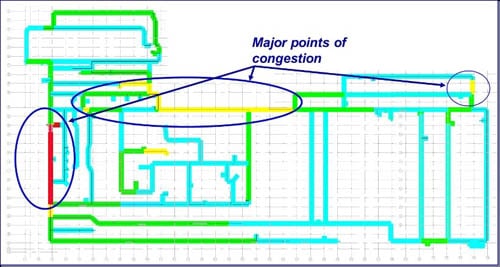 What Is Material Flow in Manufacturing? The manufacturing world has undergone a lot of changes, and it is important for businesses to make sure they do everything they can to get the most out of their resources. This is where material flow and the implementation of lean manufacturing principles when conducting an analysis is so essential.
What Is Material Flow in Manufacturing? The manufacturing world has undergone a lot of changes, and it is important for businesses to make sure they do everything they can to get the most out of their resources. This is where material flow and the implementation of lean manufacturing principles when conducting an analysis is so essential.
Material flow is one of the most important factors for production companies because businesses need to make sure they are meeting deadlines, avoiding costly mistakes, streamlining their workflow and staying within budget. That is why it is important to analyze and clearly understand how materials move between the various steps of the supply and value chains.
Material Flow Systems
Material flow systems are a sequence which include the extraction of raw materials, how the materials are processed, how the machines are used to create the finished product, and how the product is delivered to the consumer. Lean manufacturing consultants take all these factors into account when conducting an MFA with the goal optimizing the material flow of a manufacturing company for maximum efficiency.
What Are Some Examples of Material Flow in Manufacturing?
One example of manufacturing material flow is external material flow, which is usually performed using a logistics service provider. Then, in-house material flow focuses on the internal processes of a company. It includes the delivery of raw materials and subassemblies that process warehousing goods to the point they can be delivered by an external logistics company.
There are several additional examples of material flow that play a role in manufacturing. These include:

- The flow of raw materials throughout the workplace
- How the various processing methods flow together
- How finished goods flow from the business to the client
- How various operators work in sync with one another to make sure material flow is smooth
- The ability of machines to work together to create a finished product
- How information flows among machines and people to optimize the process
- How the individual engineering processes streamline the daily operations of the manufacturing company
- All of these material flows play a critical role in the efficiency of the business.
Benefits of Material Flow Analysis (MFA)
Material flow analysis in manufacturing can provide a wide variety of benefits. For example, this is a process that can streamline the flow of materials throughout the various manufacturing steps. This can remove redundancy, shorten the order turnaround time, and reduce operating expenses. By removing unnecessary steps and automating tasks that are still done by hand, it is possible to fill orders faster and more accurately, opening the door to a greater order capacity.
What this means is that customers are more satisfied. Customers are satisfied and are more likely to become repeat customers. This leads to greater revenue.
Finally, by eliminating unnecessary steps, the entire process becomes more sustainable. Ultimately, all of this can increase the profit margin of the company.
What Is Material Flow Management?
Material flow management is one of the best ways to access the benefits above. This is an industrial engineering practice that involves optimizing techniques for procuring, processing, handling, and transforming tools, parts, and numerous other important elements of manufacturing.
The goal is to optimize this process, reducing waste while helping companies get more out of their resources. There are numerous strategies in material flow management for reducing project duration, reducing costs, and improving customer satisfaction.
Lean Manufacturing Consulting Firms
Ultimately, anyone who is looking for ways to get more out of their material flow processes should rely on lean manufacturing consulting firms. Lean manufacturing involves identifying value, mapping out the value chain, and creating a smooth organizational flow. This can improve lead times, lead to sustainable business practices, and improve the quality of products.
All of this is better for the bottom line by reducing waste and cutting costs, creating a more efficient operation.